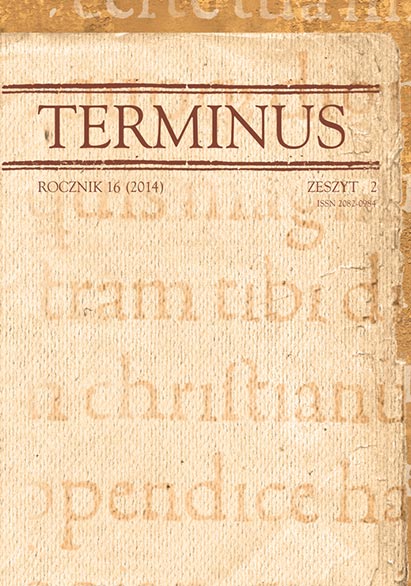Prudencja, luneta i rzeczy ostateczne. Wokół Emblemu 96 Zbigniewa Morsztyna
Prudence, telescope and eschata. Around Emblem 96 by Zbigniew Morsztyn
Author(s): Jacek KowzanSubject(s): Language and Literature Studies, Studies of Literature, Polish Literature
Published by: Wydawnictwo Uniwersytetu Jagiellońskiego
Keywords: prudence; last things; emblem studies; Zbigniew Morsztyn
Summary/Abstract: The paper is an attempt at analysis and interpretation of Emblem 96 by Zbigniew Morsztyn. The author presents the text against a broad comparative background and argues that the work is a particular study of the virtue of prudence, for which anticipating future (or more strictly speaking: last) things is a key issue. To date, the ninety-sixth emblem by Zbigniew Morsztyn, although relatively frequently studied by scholars of old-Polish literature, has not yet been comprehensively interpreted. Models of such analyses are provided in articles by Janusz Sławiński or Maria Renata Mayenowa on Emblem 102, complemented by the works of Janusz Pelc and the recent studies in the subject of emblems by Radosław Grześkowiak and Jakub Niedźwiedź. In the beginning, the author shortly outlines the history of the notion of the virtue of prudence in classical and biblical aretology as well as in Thomas Aquinas’s Summa Thaeologiae, which significantly influenced the definition of the virtue of prudence in Christianity. Later, in a detailed analysis of Morsztyn’s text the author tracks references to various elements of Prudence. It seems that (according to Morsztyn) the most important element of this virtue among those distinguished in aretology is providence, that is, the ability to anticipate future things, since this is what the posthumous fate of a man’s soul depends on. Morsztyn illustrated sensible providence using the metaphor of a telescope. This optical instrument, apparent in the iconographical schema of the original print as presented by Morsztyn, supports the cognitive abilities of man and allows him to discern future things that are crucial for his salvation, that is the last things, which he often forgets when carrying on his worldly matters. In order to show the uniqueness and originality of Morsztyn’s presentation of the subject, the author compares his works with emblem XIV from book I of Herman Hugon’s Pia desideria in the translation of Aleksander Teodor Lacki, the adaptation of Mikołaj Mieleszko and the English version of Hugon’s emblems by Francis Quarles. All these variants differ from each other in that they contain differently detailed deliberations on prudence and the last things, as well as in diverse application of the telescope metaphor. Thus Quarles shaped his emblem as a dialogue between Soul and Body in which Soul is trying to convince her interlocutor of the superiority of the telescope over the prism in the thoughtful cognition of the truth about eschata. Mieleszko, by contrast, built his emblem on the concept of a telescope that is turned over and so distances the eschatological vision. Lastly, in the subscription of Hugon-Lacki’s emblem there is no mention of the telescope whatsoever. Such comparative juxtaposition of Morsztyn’s emblem with other adaptations of the Belgian Jesuit’s work exposes not only the artistry of the synthetic presentation of the subject by the old-Polish poet, but also his aretological awareness.
Journal: TERMINUS
- Issue Year: 16/2014
- Issue No: 3 (32)
- Page Range: 323-350
- Page Count: 28
- Language: Polish

